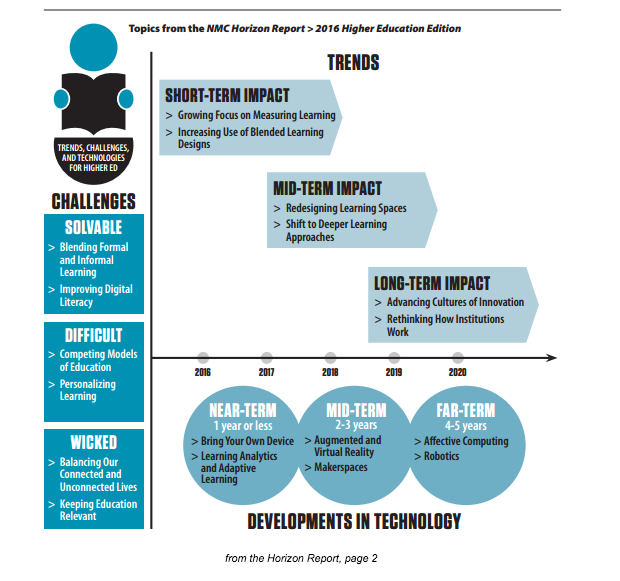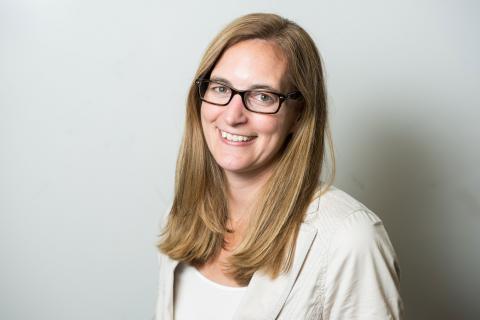Technology Tools
Behind the Scenes of the 2016 Higher Ed NMC Horizon Report
Topics

Educators often take advantage of educational technologies as they make the shifts in instruction, teacher roles, and learning experiences that next gen learning requires. Technology should not lead the design of learning, but when educators use it to personalize and enrich learning, it has the potential to accelerate mastery of critical content and skills by all students.
A window into the expert panel conversations that fueled the research presented in the NMC Horizon Report > 2016 Higher Education Edition.
Trends, challenges, and new technologies: you may have seen the headlines from the NMC Horizon Report > 2016 Higher Education Edition:

These are the influences that are pushing, pulling, and shaping technology adoption related to teaching, learning, and creative inquiry in higher education over the next five years.
I was fortunate to have a behind-the-scenes view of the report, which was produced by the New Media Consortium and the EDUCAUSE Learning Initiative. As a participant on this year’s panel, I was humbled and awed by the group I served with—leaders in the field from across the globe. The panel leaned heavy on representatives from the United States but included experts from Brazil, Australia, India, China, and other countries too.
Together, we reviewed the literature and news items surrounding emerging technologies. We responded to a series of research questions and engaged in asynchronous discussions about specific topics. Then we voted in a series of rounds to narrow down the items in each category, resulting in the key trends, significant challenges, and important developments in educational technologies that you find in the report.
The wiki is open, so you can peek into this process yourself. Here is a sampling of the conversations.
Makerspaces
“The question of how to renovate or repurpose classrooms and labs to address the needs of the future is being answered through the concept of makerspaces, which offer tools and learning experiences to help people carry out their ideas.”
This educational technology was tapped to enter mainstream use in higher education in the next two to three years. The conversation in the wiki focused on how makerspaces redefine learning spaces, and most importantly, redefine learning. Panelists emphasized the grassroots (student and faculty-driven), community-integrated, interdisciplinary nature of makerspaces as the driving force behind their ability to reshape higher education.
“Makerspaces blur the boundary between information and physical objects.”
“The MakerSpace signals a pivot from higher education's traditional, and increasingly outdated notion, of being in the business of selling content into one where skills such as creativity, problem-solving, and critical thinking come to fore.”
“The technology changes in the next few years will enable a shift from rapid fabrication of mostly inert objects to active objects (with embedded sensors, electronics, and, later, biological components). This is going to dramatically increase the space of applications for makerspaces.”
NGLC Resources on Makerspaces
- Postsecondary Trending Now: Looking to Europe for New Innovations (check out Event-based Learning and Bricolage)
- Students Design, Tinker, Create and Discover through Maker-based Learning
- How Project-based Learning Can Support Student Agency
Advancing Cultures of Innovation
Advancing Cultures of Innovation
“In order to breed innovation and adapt to economic needs, higher education institutions must be structured in ways that allow for flexibility while spurring creativity and entrepreneurial thinking. There is a growing consensus...that institutional leadership and curricula could benefit from adopting agile startup models.”
The report identifies this trend with a long-tail of impact driving ed tech adoption for five or more years. The wiki conversation was grounded in the long-held belief that higher education serves the public good, and specifically the college’s local community. Efforts that can be observed today include supporting the entrepreneurial spirit of student invention and connecting the local and campus community through innovation spaces and entrepreneurship programming. There was typical caution about higher education getting too close to industry at the expense of the liberal arts and the learning mission of an institution. But there also were calls for higher education to start to look at its own culture and adopt an innovation mindset in the way it operates.
“Entrepreneurship on campus is being supported in very specific ways beyond the classroom through Hackathons, coding boot-camps and the opening of spaces where students can meet and receive coaching from experienced entrepreneurs.”
“Higher education needs to become more entrepreneurial pairing with community and state industry leaders to ensure a seamless academic path (and preparation orientation) into the real needs of business and development.”
“Partnership with industry could lead to the mass eradication of programmes in the arts which are deemed less useful to our partners than those in business, medicine or engineering, and should be approached with extreme caution.”
“I think we often overlook opportunities to extend that thinking into our own processes. Teachers need to be entrepreneurial as they reinvent what they are doing in the classroom. This includes an iterative process of trying things out and objectively evaluating their efficacy as well as pivoting in much the same way as a successful entrepreneur might do. This also applies to the larger question of reinventing our institutions around a much more flexible way of doing business. Entrepreneurial strategies should inform all of these processes.”
NGLC Resources on Cultures of Innovation
- Building a Culture of Innovation in Higher Education: Design & Practice for Leaders
- New Report on Facing the Challenges of Innovation
- Launching a New Innovation? Don’t Go it Alone.
Rethinking How Institutions Work
Rethinking How Institutions Work
“These developments are being fueled by a growing body of research that highlights the disconnect between the demands of the 21st century economy and what college graduates are prepared to do when they leave academia…. Emerging models, such as hybrid learning and competency-based education, are revealing the inefficiencies of the traditional system for nontraditional students.”
Rethinking how institutions work is another trend impacting higher education tech adoption for five or more years. In many ways it builds on the culture of innovation trend, applied to the learning required in the 21st century and new methods of delivering learning opportunities. This is a trend we identified as a paradigm-shifter. I loved this conversation because it caused us to ask the most fundamental of questions: “What is a degree? What is a university? What is the point of either of them?”
“A piece of this is a growing recognition that seat time/credit hour is not a good proxy for learning. As calls for accountability have grown over the last decades and an awareness of, and some level of attention to, outcomes has taken hold, we're starting to ask foundational questions about the value of college in learning and what a degree actually means. Those tough questions are forcing us to take a good look at how higher ed works and rethink some of the basic assumptions, like what it is students get credit for. The tech available and the new networked/modular/personalized ways we interact with our world today are aligning with that questioning to offer new ideas on how schooling can work.”
“These are questions to which I once believed we knew the answer, but now I am not so sure. Perhaps if we can redefine their meaning, it will lead us to being able to redefine the way they work, and the way teaching and learning takes place.”
NGLC Resources on Rethinking How Institutions Work




